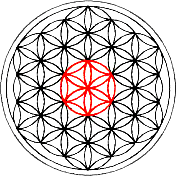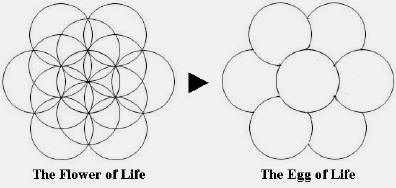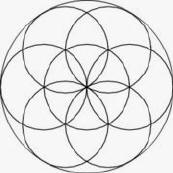Page plans for our book.
Over the past few weeks, me and Oli have been conducting lots of research around the Pyramids and their relaitionship with the constellations. We have derived lots of different chapters of research including, lifestyle, food, diet, artifacts, tools symbolism, mythology, Gods, How the pyramids were built, Intricacy in design, Sacred geometry, interesting facts and theories. So our content doesn't wander and so that we don't start to write a book that becomes a life-long dedication to Egyptology, we've started to plan out what we want to have on each spread across the whole publication. This is show below in some of the photographs I've taken. This has also given us the ability to further define our roles as designers, working on the publication together Oli is going to deal with type and layout and I will be dealing with image making and illustration, we will derive the content together.
 The flower of Life
The flower of LifeRecently I've been collecting lots of information on sacred geometry and how the pyramids were build using geometrical shapes and patterns that recure throughout maths and science today. The flower of life is a shape that is meant to be fundamental in every aspect of life and the Universes is designed around it. For our opening page, we want to give readers a quick short snappy insight to get them thinking before even beginning to fathom the rest of our content. I've been researching into the flower of life so we have a good strong symbol and shape to house our contents page and to instantly inspire readers.
________________________________________________________________________________
http://www.phoenixmasonry.org/sacred_geometry_the_flower_of_life.htm
The flower of life shape contains a secret shape known as the fruit of life that consists of 13 spheres that hold many mathematical and geometrical laws. These laws represent the whole universe. Giving the flower of life to someone is like giving them the whole universe in one jewel. The Flower of Life can be found in all major religions of the world. In Egypt, the source of all the monotheistic religions, the "Flower of Life", can be found in the ancient Temple of Abydos. In Israel, it can be found in ancient synagogues in the Galilee and in Mesada. People reported physical and psychological changes after wearing this pendant - faster heart beats, prophetic dreams, breaking of illusions, seeing the reality as it is and becoming free from long time fears. The flower of life is one of the strongest sacred geometric shapes!


http://en.wikipedia.org/wiki/Flower_of_Life
The Flower of Life is the name coined by New Age author Drunvalo Melchizedek for a geometrical figure composed of multiple evenly-spaced, overlapping circles. This figure, used as a decorative motif since ancient times, forms a flower-like pattern with the symmetrical structure of a hexagon.
A "Flower of Life" figure consists of seven or more overlapping circles, in which the center of each circle is on the circumference of up to six surrounding circles of the same diameter. However, the surrounding circles need not be clearly or completely drawn; in fact, some ancient symbols that are claimed as examples of the Flower of Life contain only a single circle or hexagon.
New Age followers ascribe many forms of significance to the Flower of Life and three similar figures, called the "Egg of Life," the "Fruit of Life," the "Seed of Life,"and the "Tree of Life." Melchizedek and others assert that these figures are symbols of sacred geometry, that they represent ancient spiritual beliefs, and that they depict fundamental aspects of space and time. They claim that Metatron's Cube may be derived from the Flower of Life pattern, and that the Platonic solids within it were "thought to act as a template from which all life springs."
The Flower of Life and the Seed of Life are linked by New Age authors with the Biblical prophet Enoch, the Archangel Metatron, the six days of Creation, the Vesica Piscis religious symbol, and Borromean rings
It was originally thought that the Temple of Osiris in Abydos, Egypt contained the oldest known examples of the Flower of Life. It is now known that an earlier example of the pattern can be seen in the Assyrian rooms of theLouvre Museum in Paris. The design forms part of a gypsum or alabaster threshold step measuring 2.07 x 1.26 meters (6.8 x 4.1 feet) that originally existed in one of the palaces of King Ashurbanipal, and has been dated to c. 645 BC.
The Abydos examples from Egypt are also worthy of note. Claims that they are over 6,000 years old and may date back to as long ago as 10,500 BC. or earlier have not yet been confirmed. Recent research shows that these symbols can be no earlier than 535 B.C., and most probably date to the 2nd and 4th century AD, based on photographic evidence of Greek text, still to be fully deciphered, seen alongside the Flower of Life circles and the position of the circles close to the top of columns, which are over 4 metres in height. This suggests the Osirion was half filled with sand prior to the circles being drawn and therefore likely to have been well after the end of the Ptolemaic dynasty.
_________________________________________________________________________________
http://www.tokenrock.com/explain-Flower-of-Life-46.html
Possibly five Flower of Life patterns can be seen on one of the granite columns and a further five on a column opposite of the Osirion. Some are very faint and hard to distinguish.

SEED OF LIFE
The 'Seed of Life' is formed from seven circles being placed with sixfold symmetry, forming a pattern of circles and lenses, which acts as a basic component of the Flower of Life's design. According to some, the seed of life depicts the 7 days of creation in which God created life.

EGG OF LIFE
The 'Egg of Life' is also a symbol composed of seven circles taken from the design of the Flower of Life.The shape of the Egg of Life is said to be the shape of a multi-cellular embryo in its first hours of creation.

FRUIT OF LIFE
The 'Fruit of Life' symbol is composed of 13 circles taken from the design of the Flower of Life. It is said to be the blueprint of the universe, containing the basis for the design of everyatom, molecular structure, life form, and everything in existence. It contains the geometric basis for the delineation of Metatron's Cube, which brings forth the platonic solids.

METATRON'S CUBE
Metatron's cube depicts the five platonic solids which may be derived form the flower of life. The five platonic solids are geometrical forms which are said to act as a template from which all life springs, according to spiritual belief. The Platonic solids are five structures that are crucial because they are the building blocks of organic life. These five structures are found in minerals, animated and organic life forms, sound, music, language, etc. Metatron's cube is also considered a holy glyph, used to ward off evil spirits. The Kabbalah's Tree of life is also thought to be derived from the flower of life.

The following are some of the locations in which the Flower of Life symbol can be seen:
The Temple of Osiris at Abydos, Egypt contains the oldest known examples of the Flower of Life. They are at least over 6,000 years old and may date back to as long ago as 10,500 B.C. or earlier. It appears that it had not been carved into the granite and instead may have been burned into the granite or somehow drawn on it with incredible precision. It is thought to possibly represent the Eye of Ra, a symbol of the authority of the pharaoh. Other examples can be found in Phoenician, Assyrian, Indian, Asian, Middle Eastern.
